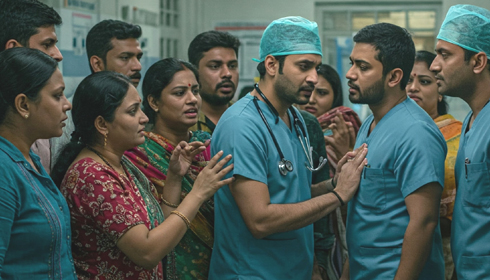
How India can Tackle Its Patient-Doctor Conflict in Public Healthcare
Recently, India's public healthcare system has seen increased conflicts between patients and providers, with communication breakdowns undermining trust and jeopardising service quality. The National Institute of Health and Family Welfare (NIHFW) intervention, set to be implemented countrywide in 2025-26, aims to address this problem by providing specialised training for medical workers, consequently altering patient-doctor interactions across the country.
The Communications Crisis
Several studies indicate that patient-doctor communication in India's overburdened public healthcare system is at a crucial point. For example, In a 2021 study the researchers discovered that 72% of patients were dissatisfied with communication across medical departments, with women reporting higher levels of unhappiness than men. According to the same study, 60% of patient concerns were not addressed with a personal apology or direct reaction, continuing cycles of mistrust that hinder effective care.
These findings are consistent with the experiences of Zahir Ahmed(name changed), a 45-year-old Delhi resident who felt dehumanised during hospital sessions. "I felt like a case file, not a person." This anecdotal evidence is consistent with broader trends; 65% of patients in a 2020 cross-sectional study, wherein researchers expressed comparable symptoms of depersonalisation.
Systemic Challenges
Several factors contribute to India's communication gap. The doctor-patient ratio is 0.7 physicians per 1,000 people, which is below the World Health Organisation's (2016) recommendation of 1:1,000. Overburdened medical personnel, coping with heavy patient loads, frequently have little time to interact effectively.
Historically, India's medical education system has placed little emphasis on "soft skills." While the Medical Council of India (2015) stressed the importance of early communication training, real implementation has lagged. Poor communication has been linked to negative health outcomes, according to research. In a 2019 study, researchers discovered that patients who perceived poor communication were 40% more likely to terminate therapy prematurely, resulting in higher healthcare costs and worse clinical outcomes.
NIHFW Intervention
Recognising critical gaps in patient-physician communication, the National Initiative for Holistic and Family Welfare (NIHFWH), set to launch in 2025-26, aims to address these deficiencies through targeted training for medical professionals at premier institutions such as AIIMS Delhi, Safdarjung Hospital, and RML Hospital.
According to media report, the program's comprehensive courses are intended to develop important interpersonal skills. First, role plays and case simulations are used to create empathy and rapport, allowing clinicians to appropriately recognise and respond to patients' emotional states.
Second, active listening techniques are refined through workshops that emphasise paraphrasing and open-ended inquiry so that patients feel truly understood. Third, conflict resolution and de-escalation skills are created through group discussions and scenario-based exercises, allowing clinicians to manage and resolve patient complaints more proactively. Finally, cultural and social sensitivity is developed through lectures and peer-learning sessions, which highlight India's vast sociocultural diversity and ensure that healthcare delivery is adapted to individual patients' distinct backgrounds.
According to Dr. Anjali Gupta of AIIMS, who participated in an early pilot program, "recognising patients' emotional experiences along with their physical symptoms is transforming how we deliver care." Measurable outcomes include patient satisfaction surveys, complaint decrease rates, and increased treatment adherence.
Dr. K. Srivastav and Dr. Preeti Swaminathan, program creators, emphasise that the purpose is to transmit more than just "communication tips." "We're fostering a mindset shift," explains Dr Srivastav. "Doctors need to recognise that healing is both a clinical and relational process."
Addressing violence and miscommunication.
The NIHFW project comes at a crucial moment as a 2022 study found that 75% of Indian doctors have experienced verbal or physical abuse at some point in their employment, which is frequently caused by communication breakdowns or misconceptions about treatment outcomes.
The NIHFW's training attempts to reduce these events by incorporating patient-centered approaches and conflict resolution strategies.
"A doctor's role is not only to treat bodies but also to heal people in their social and cultural contexts," Dr. Dhirendra Shastri, the program's principal consultant while talking to media.
Potential challenges and criticisms
Despite the encouraging trial results, expanding the program nationally will be difficult. Critics refer to India's continued medical manpower shortages and institutional constraints in public hospitals, which may prevent consistent training and execution.
Furthermore, some sceptics wonder if short-term training can effectively address long-standing challenges, like overcrowded facilities and underfunded infrastructure.
Addressing these problems necessitates more financing for communication training, the incorporation of soft skills into medical curriculum, and long-term research into how these treatments affect patient outcomes and costs.
Charting a Path Forward
The NIHFW’s communication training program is a significant step towards rebuilding trust and improving treatment in India's public healthcare system.
This project recognises the importance of effective communication in developing strong patient-provider relationships, which are the foundations of successful treatment.
However, to cement and broaden the programme's impact, many critical actions are required. First and foremost, providing ongoing financial support is critical to ensuring widespread adoption of the training across India's huge and diversified public health infrastructure.
This funding commitment will allow the initiative to reach additional healthcare professionals, increasing its scope and efficacy. Second, the country must integrate communication courses into fundamental medical and nursing curricula. By including these abilities in the basic training of future healthcare practitioners, India may foster a generation of experts who value patient-centered communication. Finally, it will be critical to carefully and continuously monitor long-term outcomes, such as clear decreases in patient complaints, measurable improvements in clinical adherence, and a considerable decrease in workplace violence. This data-driven approach will not only prove the program's efficacy but will also provide significant insights for future refinement and optimisation, ensuring that the NIHFW's communication training program reaches its full potential for reforming India's public healthcare system.
Finally, technical advancements and regulatory reforms will have little influence if patients feel disregarded and undervalued. By promoting person-centred care and encouraging empathic communication, India can build a healthcare environment in which both patients and providers thrive—one conversation at a time.